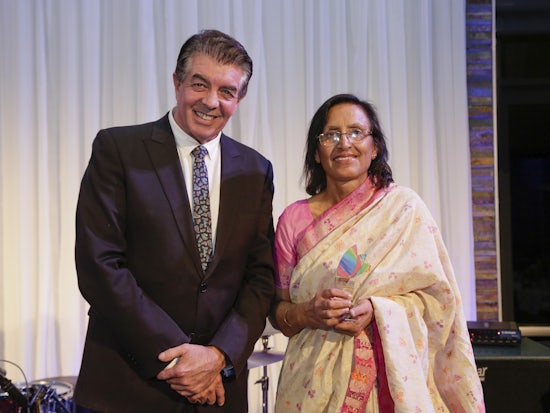Indian community needs attention in aged care
An article written by Vijay Badhwar and Kanwaljit Kanwar from Indian Down Under about aged care planning for Indian seniors in Australia won the Best Editorial/Commentary at the NSW Premier’s Multicultural Media Awards late August.

Minister for Multiculturalism Ray Williams presents the award to Editor of Indian Down Under Neena Badhwar (Source: Multicultural NSW)
The article focuses on the lack of planning in regards to aged care services for the growing elderly population within the Indian community. Prompted by the lack of discussion Mr Badhwar hopes to bring this issue to light.
Mr Badhwar states that it is a relatively new matter due to the migration of Indian citizens to Western areas, most commonly attributed to family reunions. As the Indian population is migrating to and growing in Western areas, the issue of aged care for Indian residents is an increasing concern.
This is also proving to be a more prominent issue in particular for those who require a higher category of care that current families are unable to provide. Currently the majority of senior citizens in the Indian community are comfortably living with their families.
Mr Badhwar’s article, ‘Old age is catching up, so plan‘, states that “there are already a sizeable number of Indian seniors who are in need of dire services, currently estimated to be more than 25,000”. It is also estimated that by 2050 the number of seniors dependent on these services will increase to 3.5 million. Key factors that impact on this issue include cultural differences and government funding.
The setup of aged care homes in India are different to that of Western homes. Mr Badhwar recounts of the time he visited aged care homes in India and the differences between the environments of Western aged care homes.
Religious considerations include temples inside aged care homes. Dietary requirements are also taken into account, with foods being vegetarian or mostly vegetarian. Some homes also have extra kitchens in addition to the main kitchen, along with food vendors dropping by to offer alternatives.
Mr Badhwar suggests that due to the differences in Western and Indian cultures (and consequently aged care facilities), uprooting the seniors from what they are familiar with can pose harmful mental effects on seniors. He suggests that to be more culturally inclusive, aged care homes prioritise certain elements to accommodate for citizens who may be experiencing difficulty adapting.
“The first and foremost priority would be to cater to dietary requirements [provide vegetarian options], with the second priority to focus on culture and company,” he says.
Community leaders are working towards implementing these options, however many of these factors are financially dependent.
Mr Badhwar is also critical of the accommodation payments residents are required to provide to homes, stating that it “makes people sell their efforts”. He concludes that “the government has to think about the providers as well as the people [clients].”























